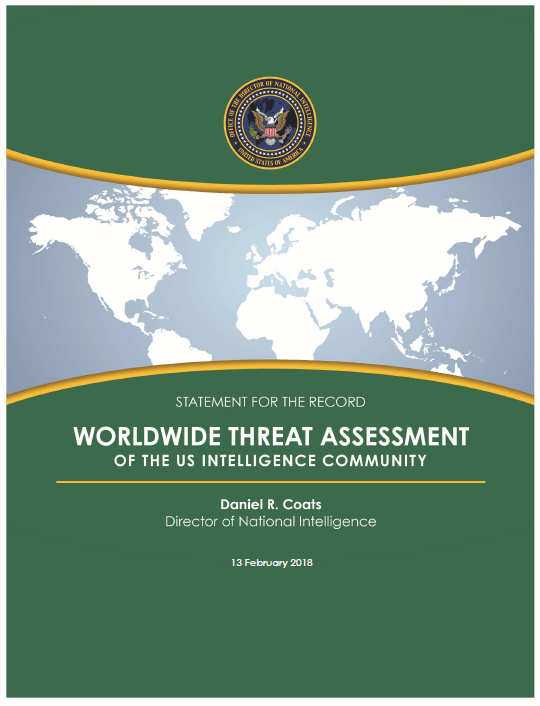 ODNI
ODNI
DNI Worldwide Threat Assessment Notes Climate Security Threats
As a part of the Director of National Intelligence Daniel Coats’ testimony before the Senate Intelligence Committee, the Office of the Director of National Intelligence released the latest Worldwide Threat Assessment of the U.S. Intelligence Community, outlining the major threats to national security around the world. From cyber to terrorism to space, the assessment provides insight into what the U.S. Intelligence Community is most concerned about. One of the threats referenced at the end of the assessment is the impact of climate change on human security. This shows that the Intelligence Community continues to take climate security seriously in this Administration, as they should. Still, the section leaves some room for improvement; missing an opportunity to illustrate how the impact of climate change interacts with other threats.
The human security section outlines four main areas of concern, noting that “the impacts of the long-term trends towards a warming climate, more air pollution, biodiversity loss, and water scarcity are likely to fuel economic and social discontent-and possibly upheaval.” In relation to climate, the assessment notes that extreme weather can “compound with other drivers to raise the risk of humanitarian disasters, conflict, water and food shortages, population migration, labor shortfalls, price shocks, and power outages.” Further, these impacts could happen rapidly without much warning. The assessment goes on to outline the potential for worsening air pollution, accelerating biodiversity and species loss, and water scarcity to undermine vital economic and basic life needs and lead to instability. This is a critical concept to understanding the climate threat. Climate change is often referred to as a “threat multiplier” due to its ability to cause a wide range of secondary and tertiary impacts. With concern about the growing influence of China and failing nations like Yemen, any potential for added instability should be monitored and mitigated.
This threat assessment adds to a significant number of national security reports that reference the security threats of climate change. From the Department of Defense’s 2014 Quadrennial Defense Review, to their 2016 Directive on Climate Change Adaptation and Resilience, to the 2016 DNI report on the Implications for U.S. National Security of Anticipated Climate Change, the national security community has been at the forefront in pointing out this threat. Even more recently, Congress voted in support of an amendment in the 2018 National Defense Authorization Act noting that climate change was a “direct threat to the national security of the United States” and requested a report on America’s most vulnerable bases. This new DNI assessment reinforces the previous work and progress made within the security community to address climate change.
While the assessment does outline some of the main impacts of climate change, the analysis only briefly mentions this critical threat. The overall report covers a broad range of security threats and most of these threats will be impacted by climate change, making addressing each vulnerability much more difficult. An ideal document would emphasize this characteristic of climate change; incorporating it into each relevant threat instead of relegating it to a separate, short section at the end. For example, the section on terrorism covers some of the key terrorist threats around the world, notably, Sunni Violent Extremism, ISIS, and Al-Qaeda. Each of these groups exploit instability within or between countries. The assessment missed an opportunity to explain how the effects of climate change on human security can lead to growing pockets of instability, opening new areas for terrorism to flourish.
Identifying and addressing the linkages between threats is critical for effective intelligence. The characteristic of climate change to act as a threat multiplier makes it a key component when evaluating any future security vulnerability. The inclusion of climate change in the most recent DNI threat assessment proves that the intelligence community understands this. They should continue to incorporate it into its analysis of all threats, regardless of partisan debates.
Additional media coverage featuring ASP available here:
Intelligence official warns of ‘abrupt’ change by Hannah Northey and Nick Sobczyk, E&E News





